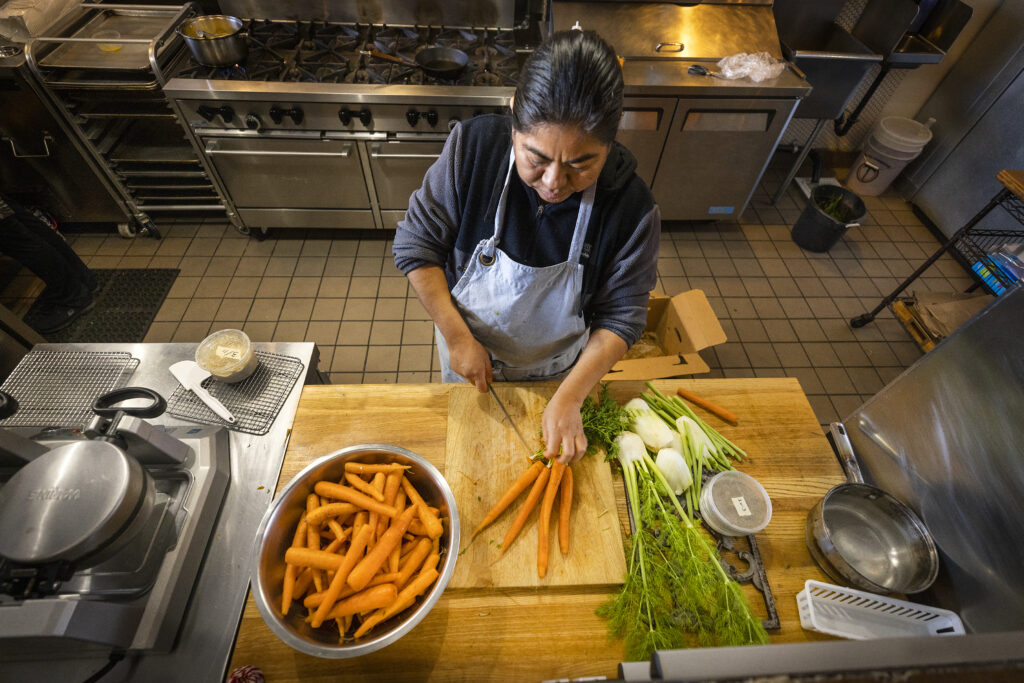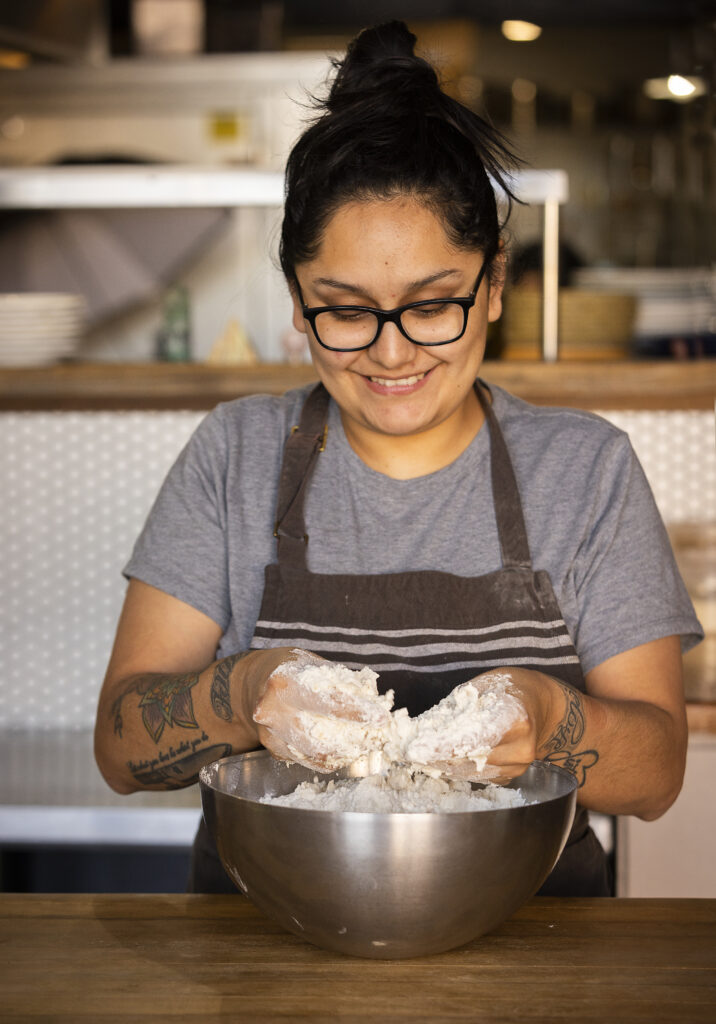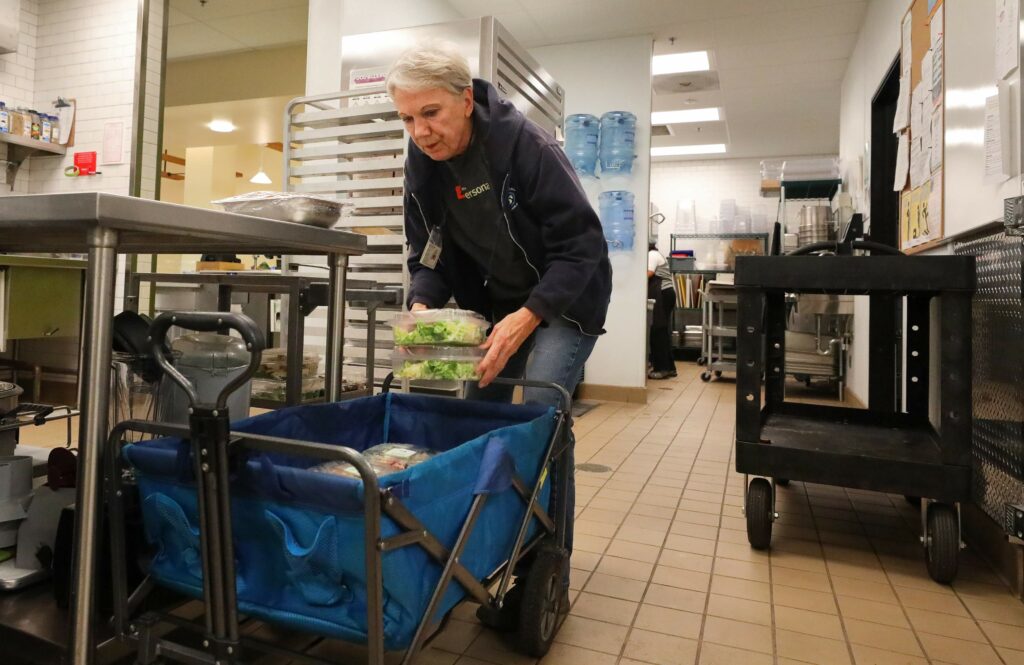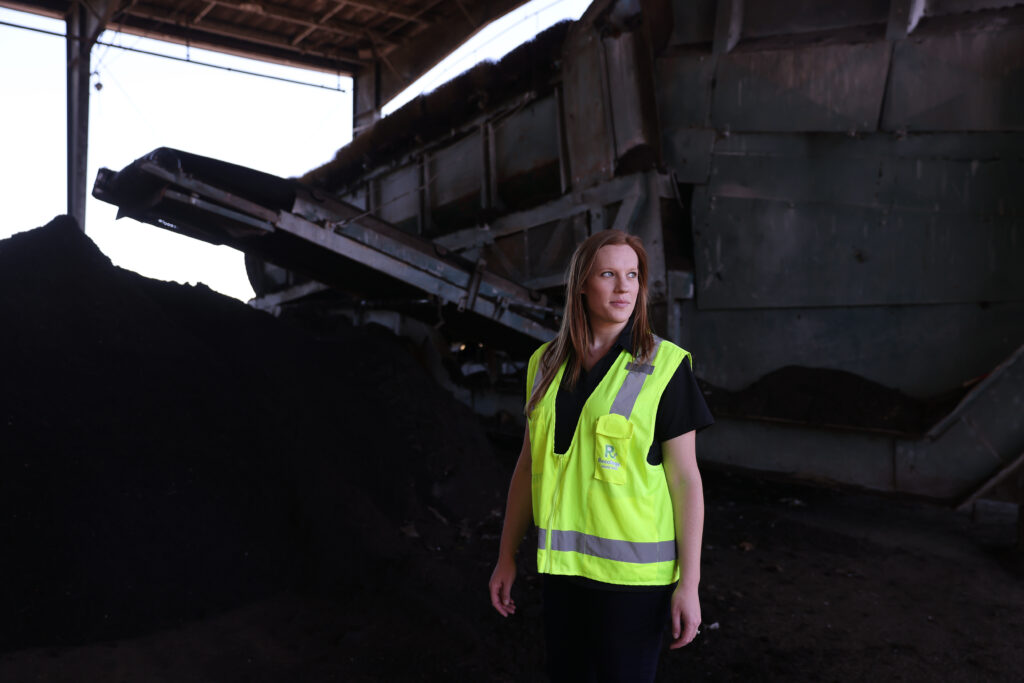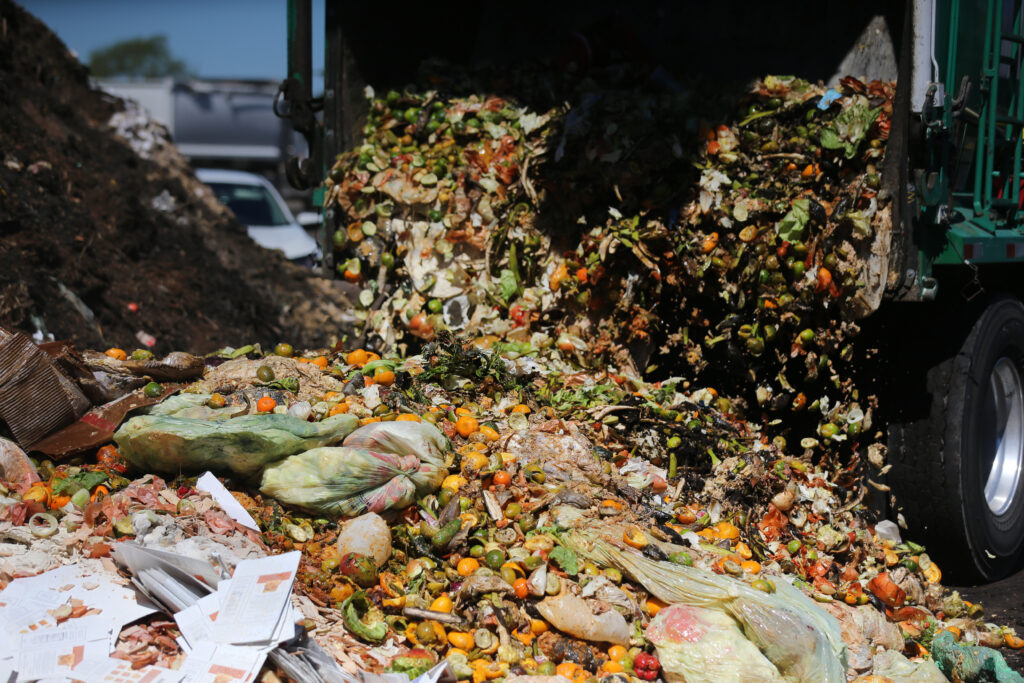A wall inside the Naked Pig in downtown Santa Rosa is lined with colorful jars of preserved tomatillo salsa, fermented ketchup, and three types of quince preserves. The counters are adorned with vases of lacy fennel fronds, yellow sorrel flowers, miner’s lettuce, and an avocado fallen from a nearby tree. And the menu offers a decadent waffle topped with jam made from Santa Rosa plums picked just down the street.
“I don’t waste food, but one of the things I do is forage food, especially locally,” says chef/owner Dalia Martinez. “We have an excess amount of food trees. I’ve been in the practice now of collecting these urban foraged fruits. I use them to make jam, soda syrups, and whole preserved fruit for the restaurant.”
Martinez, who was raised in Santa Rosa, also saves scraps from the kitchen for the worms in her home compost bin, to be converted to nutrients for her flower and herb garden. She orders ingredients judiciously and adjusts portion sizes and sides to give guests more of what they want and less of what they don’t — and sends whatever is scraped from their plates to the green bin out back for pickup by local waste servicer Recology, which takes the materials to an industrial composting facility.
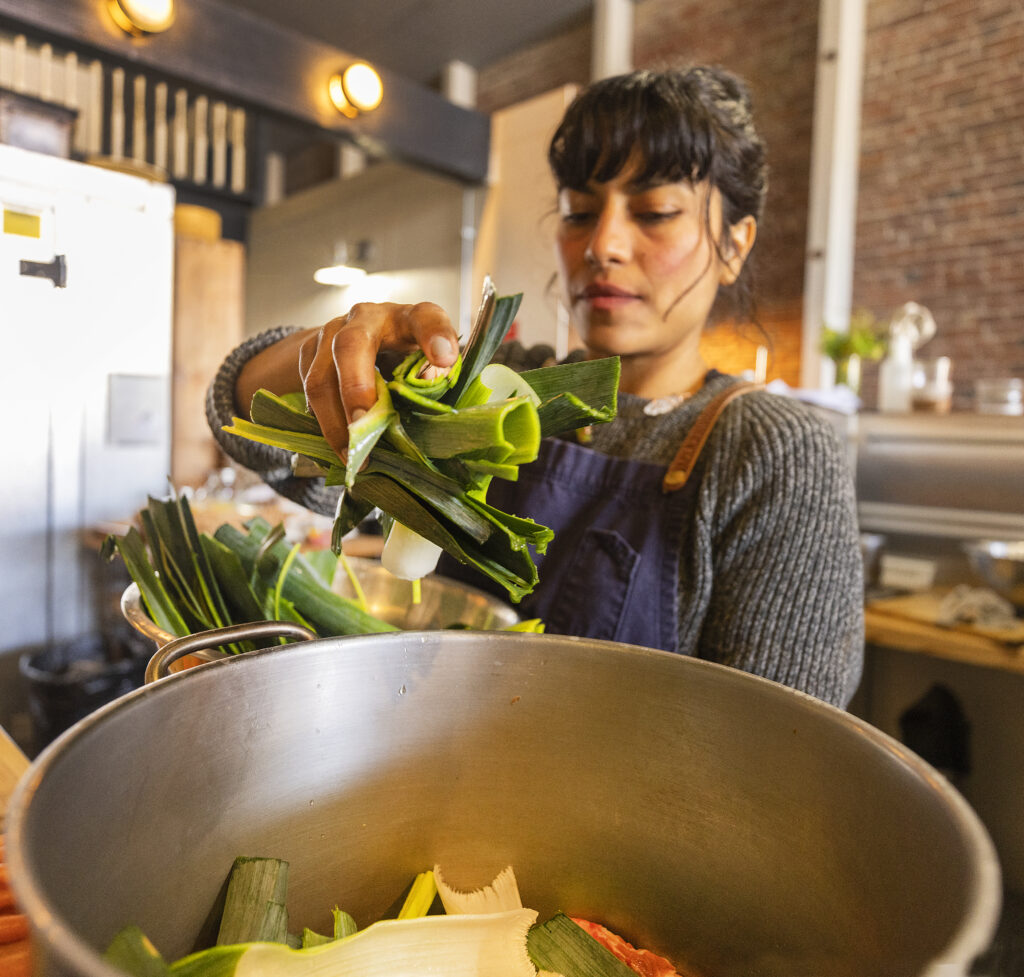
With a passion for snout-to-tail, root-to-flower cooking, Martinez is a true believer in the idea that no edible food should go to waste. But she’s far from alone in Sonoma. The Naked Pig is among 14 restaurants countywide to be recognized by Slow Food USA for its social and environmental practices, and plays one part in a larger system of farms, eateries, and food-gleaning organizations working daily to reduce food waste.
In fact, every Sonoma County restaurant is now involved in the effort: composting, once the province of crafty home gardeners, is now California law. Senate Bill 1383, passed in 2016, requires that as of this past January, all restaurants send their food scraps and soiled napkins not to the trash, but to the organics bin for separate pickup. This ensures that their green waste gets a second life — and potentially a third, fourth, and so on — as nutrient-rich compost.
Composting brings the additional benefit of drastically reducing greenhouse gas emissions that occur when food and other organic matter slowly decompose in a typical municipal landfill. In California, landfills are the third-largest source of methane emissions, responsible for about 20% of the state’s total. Methane is an especially bad climate actor: while it persists for a relatively short time in the atmosphere, it is 84 times more potent than carbon dioxide.
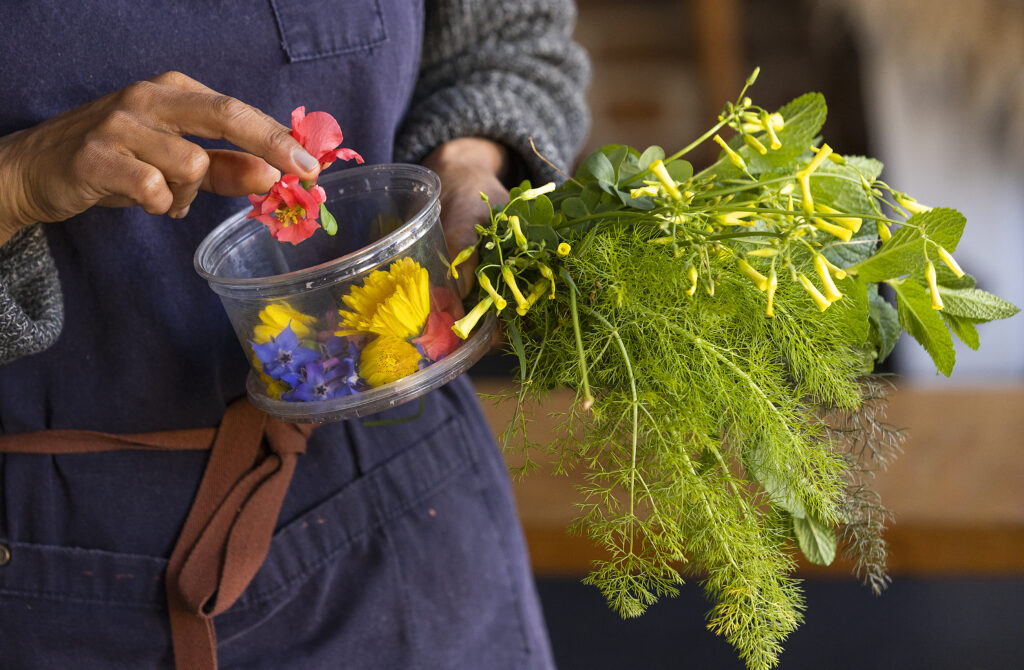
At first, Gustavo Gutierrez of Los Tres Chiles in Santa Rosa’s Bennett Valley neighborhood thought composting would be a financial burden for his popular Mexican restaurant. “I remember when [Recology] approached us for the very first time. ‘Oh my God, how much is this going to cost?’ he recalls thinking. “At the end of the day, it’s like, ‘What is this going to cost me?’” He hesitated, but eventually signed on. He got new green bins for the kitchen, bought compostable bags to line them, and began training employees on what went where. After a couple months, separating out organics and keeping the bins clear of non-compostable contaminants became second-nature, Gutierrez says.
That’s when reality set in: Composting wasn’t costing him money — it was saving it. “We went from a big bin of just garbage to the smallest bin of garbage that we can get,” he says. “Every penny that you spend for that program, it’s worth it, to see the reduction in garbage — and actually, you save money because your bin is now smaller.”
Los Tres Chiles downsized from a 3-cubic-yard bin to a 1-cubic-yard bin in the alley out back, saving plenty on weekly trash service. Similarly, in the kitchen, which was once replete with waste bins, staff now slide or dump veggie scraps, leftovers, and other organics into one of four green bins. Landfill waste — mostly plastic bags that held tortillas, chicken, or other ingredients — is collected in just a single trash can.
After its trucks make their rounds to restaurants like Los Tres Chiles all over Sonoma County, Recology delivers organic waste to a commercial compost facility in either Richmond or American Canyon, says Recology’s Waste Zero department manager Celia Furber. (Residential green waste goes to either Ukiah or Novato.) Owners of these facilities then sell most of the compost they’ve made to individual farms and wineries throughout the region, Furber explains.
Compost can also be used by local ranches. Research from the Marin Carbon Project, a consortium of public agencies, nonprofits, and university researchers, has shown that compost applications to grassy or shrubby rangelands — which make up roughly a third of the land in Sonoma County — can further mitigate climate change by promoting plant growth, which then sequesters carbon in the soil.
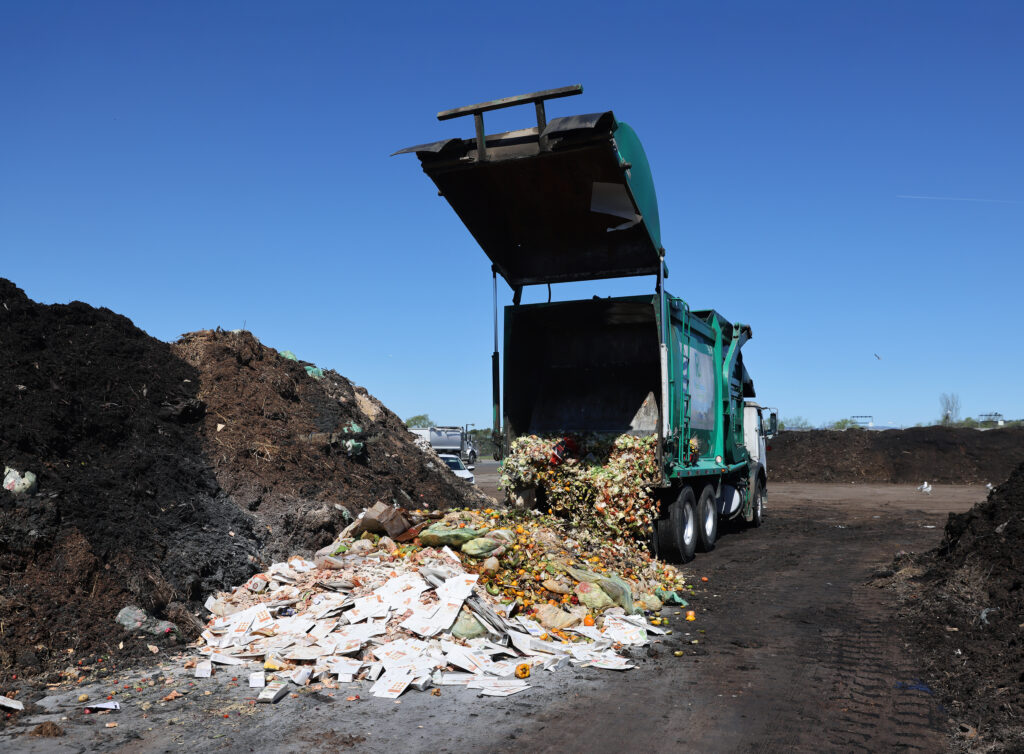
In addition to the new composting rules that took effect in January, a second component of SB 1383 that’s still being rolled out addresses another, arguably more egregious form of waste: usable, edible food being thrown away in the trash.
The law requires that by 2024, large restaurants, hotels, cafeterias, event spaces, and other venues donate all surplus edible food and produce to food-recovery organizations and services. This requirement is already in effect for grocery stores, wholesale food vendors, and food distributors.
Restaurants in Sonoma County generally do a good job of not throwing away edible food, says June Michaels, founder of Sonoma Food Runners. The nonprofit’s mission is to alleviate hunger and prevent food waste by collecting and distributing quality perishable and prepared foods that would otherwise go to waste. Almost one in four Californians doesn’t have enough to eat, according to CalRecycle.
At many restaurants, excess food gets integrated into new dishes or is fed to workers, Michaels explains. A handful of local restaurants do occasionally call her up to donate, and one café offers baked goods on a weekly basis. “The chefs get super-creative, and I admire that,” Michaels says. “If they have anything they want to donate, they know they can trust us to pick it up safely and take it to someone who needs it.”
When the new food-recovery law for restaurants takes effect in 2024, donations to Sonoma Food Runners and similar local organizations could increase. Xinci Tan, organics program manager for Zero Waste Sonoma, a regional government agency operating programs to reduce landfilled waste, says about 30 restaurants in the county are large enough to be affected by the new requirement. They’ll be on the hook to promptly donate any edible, if less-than-perfect, food they may currently find more convenient to trash than to serve to those in need.
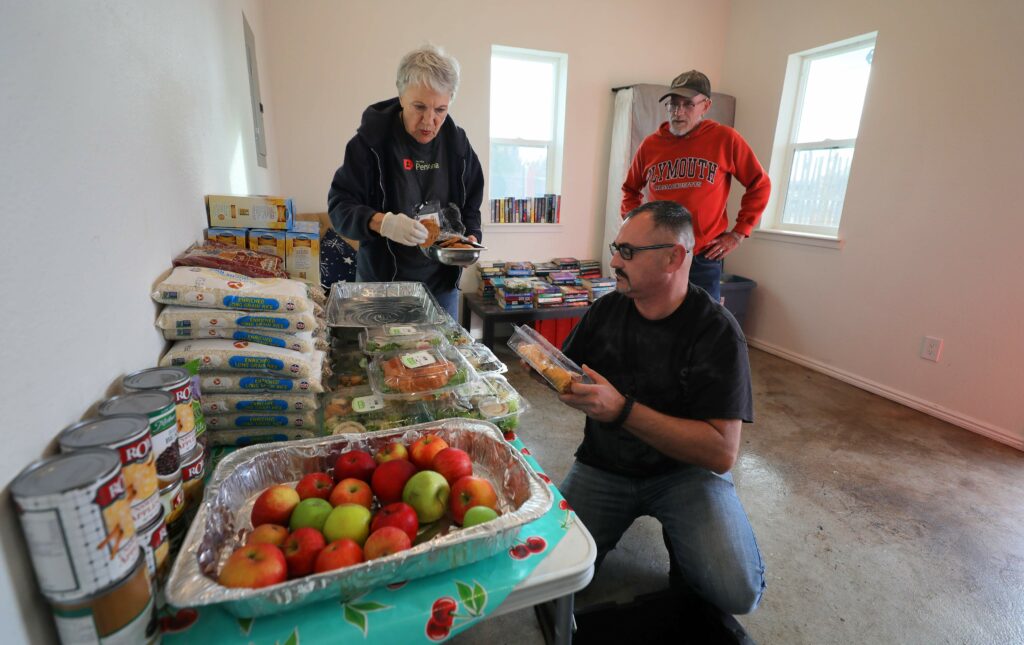
Simultaneously, broader business forces are converging to help prevent waste, even before meals are made. Restaurants of all sizes, still reeling from the pandemic, now face rising food costs due to supply-chain disruptions, transportation costs, and inflation, in addition to drought and other climate impacts. Buying too much is a major liability.
Crista Luedtke, chef/owner of boon eat + drink and Brot restaurants in Guerneville, believes that reducing food waste is increasingly critical for restaurants in today’s economic environment. “Everyone in the business, we all have to be focused on it,” she says. “Margins are so slim, and food waste heavily impacts that and your ability to be successful.”
From this perspective, even kitchen scraps dutifully diverted from the trash to the compost can look like waste. The Environmental Protection Agency has designed a “Food Recovery Hierarchy” that helps make this clear. At the tip of the pyramid is landfill/incineration, the least-preferred option, and the last resort for food disposal if no other options are available. Until recently, this choice has been the status quo for many restaurants and other businesses that handle food, including supermarkets.
After landfilling, the next-best alternative is composting. Better yet are industrial uses like converting cooking oil into biodiesel; feeding animals (a fairly common practice in Sonoma County); and, of course, feeding hungry people by donating surplus edible food to food banks, soup kitchens and shelters.
Finally, the base of the pyramid is source reduction — creating less food waste in the first place. This is where restaurants can save money by ordering ingredients more conservatively and by converting what some may consider scraps into perfectly good food — even exciting and innovative haute cuisine, many local chefs say.
“Right now, the cost of everything is going up,” says Dino Bugica, head chef and owner at Geyserville restaurant Diavola Pizzeria & Salumeria, another Slow Food award recipient. “We just try to be really smart with the menu … We try to have a plan. We look at the menu: ‘This is where this goes, this is where this goes.’ It’s kind of fun to puzzle it all together.”
What that puzzle looks like varies from season to season, Bugica says. “Right now, with a lot of vegetables, like the spring garlic, spring onion tops, and all the little artichoke and asparagus shavings, we make a really nice vegetable stock.”
Bugica also features high-quality seafood and meats on his menu, all parts of which eventually end up in recipes. Trimmings from beef and pork and pieces of fish or shrimp can be reduced in a sauce and then frozen for later use. Even fish bones and heads can be dehydrated and turned into powder for use in sauces.
“Some of that stuff is traditional,” Bugica says. “I mean, people have been preserving stuff forever. So it’s kind of a good reminder about just keeping the pantry stocked. You never know when you’re gonna need that roasted fish bone sauce.”
At Crista Luedtke’s boon eat + drink, reducing waste at the source means noticing what’s left on people’s plates so portion sizes can be adjusted accordingly, and being diligent about ordering to avoid unused ingredients. “It’s crucial to the vitality of my operation for us to have very little food waste and food loss,” she says. “We’re keen on planning appropriately, so we can make sure that we move it, as opposed to lose it.”
Whatever it takes, believes June Michaels, who worked in restaurants and catering all over the country before forming Sonoma Food Runners. “We live in an abundant region of some of the world’s finest food producers,” she says. “It is a sin to waste the food, the water it took to grow it, the fuel it took to transport it, and the labor and talent it took to plant, harvest and prepare it.”













